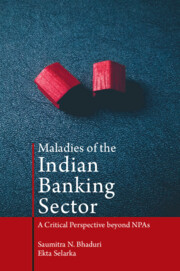Book contents
- Frontmatter
- Dedication
- Contents
- List of Figures
- List of Tables
- Foreword
- Acknowledgements
- 1 Prologue
- 2 The Indian Banking Sector: A Brief History
- 3 The Index of Credit Allocative Efficiency
- 4 Macroeconomic Analyses of Bank Credit Misallocation in the Indian Corporate Sector: Investigation of Pro-cyclicality
- 5 Determinants of Bank Credit Misallocation: Firm-level Analysis
- 6 Allocative Efficiency of Bank Credit and Firm Performance
- 7 Credit Reallocation by Indian Banks in the Aftermath of the Global Financial Crisis
- 8 The Zombie Story: Credit Boom and the Rise of Zombie Firms in the Indian Economy
- 9 Epilogue
- Bibliography
- Index
Foreword
Published online by Cambridge University Press: 27 September 2022
- Frontmatter
- Dedication
- Contents
- List of Figures
- List of Tables
- Foreword
- Acknowledgements
- 1 Prologue
- 2 The Indian Banking Sector: A Brief History
- 3 The Index of Credit Allocative Efficiency
- 4 Macroeconomic Analyses of Bank Credit Misallocation in the Indian Corporate Sector: Investigation of Pro-cyclicality
- 5 Determinants of Bank Credit Misallocation: Firm-level Analysis
- 6 Allocative Efficiency of Bank Credit and Firm Performance
- 7 Credit Reallocation by Indian Banks in the Aftermath of the Global Financial Crisis
- 8 The Zombie Story: Credit Boom and the Rise of Zombie Firms in the Indian Economy
- 9 Epilogue
- Bibliography
- Index
Summary
Dr Saumitra N. Bhaduri and Dr Ekta Selarka have written an extremely valuable book on the performance of Indian banking. The Indian banking system is currently passing through an extremely difficult phase. The non-performing asset (NPA) ratio has reached a very high level. This has its own impact not only on profitability of banks but on their entire functioning. What has led to this situation? Bhaduri and Selarka go beyond NPAs and analyse one key question of how well the banks have performed their major responsibility of allocating resources efficiently. The book is an eye-opener for understanding the NPA malady haunting Indian banks.
In any economy, the financial sector plays a major role in the mobilization and allocation of savings. Financial institutions, instruments, and markets which constitute the financial sector act as a conduit for the transfer of financial resources from net savers to net borrowers – that is, from those who spend less than they earn to those who earn less than they spend. The financial sector performs this basic economic function of intermediation essentially through four transformation mechanisms: liability–asset transformation, size transformation, maturity transformation, and risk transformation. The process of financial intermediation supports increasing capital accumulation through the institutionalization of savings and investment and, as such, fosters economic growth. The gains to the real sector of the economy, therefore, depend on how efficiently the financial sector performs this basic function of financial intermediation. Thus, a critical function of banks is one of allocating the resources raised through deposits efficiently – that is, loans being given to those borrowers who rank higher in terms of productivity of capital.
The period from 2005–06 to 2010–11 was marked by an extraordinary increase in the provision of credit by the banking system. This also coincided with a boom in real economy. The Indian economy grew at an average annual rate of 8 per cent during this period. What started as a ‘rational’ exuberance became an ‘irrational’ exuberance of lending. To study whether there has been a misallocation of resources, the authors compute what we call an ‘index of credit allocative efficiency’. Their conclusions are staggering.
- Type
- Chapter
- Information
- Maladies of the Indian Banking SectorA Critical Perspective beyond NPAs, pp. xv - xviPublisher: Cambridge University PressPrint publication year: 2022



